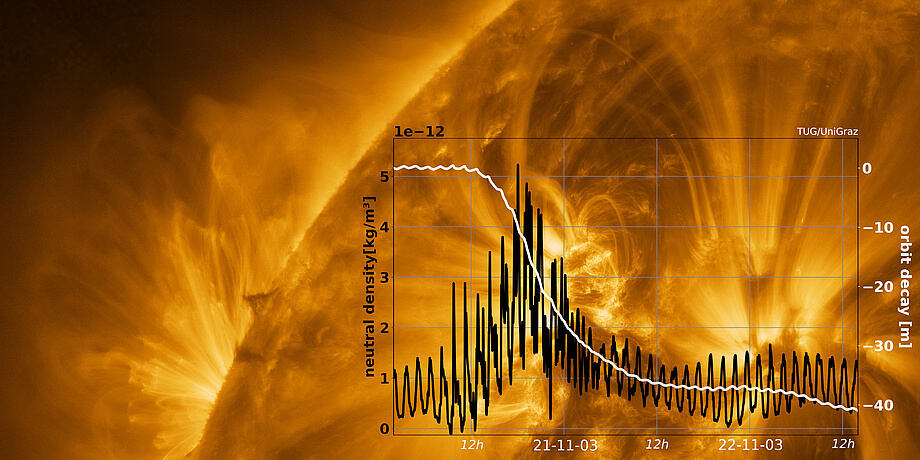AEROSPACE
Austrian scientists develop forecasting service for ESA's Space Safety Program

When it comes to space exploration, the safety of satellites is of utmost importance. But how can we predict and protect against the dangers of space weather? The effects of solar storms on Earth's atmosphere can crash satellites. Scientists from the Technical University Graz and the University of Graz in Austria have developed a new SODA forecasting service for the European Space Agency's Space Safety Program, claiming to provide a reliable and accurate way to anticipate the risks of space weather. But is this new service really up to the task?
After a successful test phase, the SODA ( Satellite Orbit DecAy ) service jointly developed by Graz University of Technology and Graz University of Technology has been part of the Space Safety Program of the European Space Agency ESA since mid-July. SODA provides accurate forecasts of the effects of solar storms on the orbits of low-Earth satellites. This makes TU Graz only the third Austrian institution to contribute to this ESA program. In addition to Seibersdorf Laboratories, the University of Graz had previously been part of the program with the Kanzelhöhe Observatory and the Institute of Physics.
The new forecast service is freely available via the ESA Space Weather Service and offers a warning time of around 15 hours. Since solar activity is expected to reach its maximum in the next two years, the commissioning of SODA is of additional relevance at the current time. The extent to which solar storms can affect the satellite orbit has already been demonstrated in the SWEETS project, which is funded by the Research Promotion Agency (FFG).shown, on whose results SODA is built. In this project, atmospheric density data was combined with real-time measurements of solar wind plasma and the interplanetary magnetic field to calculate the effects of solar events. During a large coronal mass ejection from the sun, it was found that satellites at an altitude of 490 kilometers lost up to 40 meters in altitude. At the beginning of February 2022, 38 Starlink satellites even crashed during commissioning at a flight altitude of 210 kilometers due to a solar storm.
Solar activity heading to a peak
The main reason for this is that the charged plasma particles that hit the earth's magnetic field after a solar flare heat up the upper layers of the earth's atmosphere so much that they expand and air resistance increases. This costs satellite speed and altitude. Due to the expected increase in solar activity over the next two years, ESA has already lifted some of its satellites several kilometers to safely get through this period. With its predictions, SODA is intended to create additional security. The Graz University of Technology contributed its expertise in the processing of satellite data at the Institute for Geodesy for the forecast service, while the University of Graz contributed its experience in the field of solar and heliosphere physics and interplanetary magnetic field observation.
The team around Sandro Krauss at the Institute for Geodesy at TU Graz dealt with the determination of atmospheric densities over a period of 20 years. To do this, they drew on data from several near-Earth satellite missions, including the CHAMP, GRACE, GRACE Follow-on, and Swarm missions. At the University of Graz, the research group led by Manuela Temmer from the Institute of Physics analyzed around 300 cataloged solar flares from the years 2002 to 2017 based on measurements of the interplanetary magnetic field by probes at the so-called Lagrange point L1, which is about 1.5 million kilometers in the direction of the sun's flight is distant from the earth. The Graz University of Technology used the information from the University of Graz to link changes in the density of the atmosphere to solar flares. The SODA prediction model was created from the overall analysis of the data collected in this way.
Space research is very important in Austria
"I am very pleased that with SODA we are now, with TU Graz, the third institution to contribute to ESA's Space Safety Program alongside the University of Graz and Seibersdorf Laboratories," says Sandro Krauss from the Institute for Geodesy at TU Graz. “Of the five Expert Service Centers in the ESA Space Weather Service Network, Austria is represented in four; only Great Britain is involved in all five centers. This shows that Austrian space research is of great importance. The cooperation with the University of Graz on this project is also proof of how valuable interdisciplinary research work is. We are already working together to further improve SODA.”
Manuela Temmer from the Institute of Physics at the University of Graz explains: "For the University of Graz and the Graz University of Technology, it is a nice recognition of our work that we can supply the ESA with this service. I am also pleased that the cooperation is continuing. As part of the CASPER project funded by the FFG, we will improve SODA together. It should serve to better understand more complex solar storms, for example when two storms overlap on the way to Earth. Furthermore, we would also like to calculate the atmospheric density at an altitude of 450 and 400 kilometers - so far we have been able to do this up to 490 kilometers. Since the field of solar storm forecasting has not yet been very well researched, many interesting findings are still waiting for us.”
The new forecast service developed by TU Graz and Uni Graz for ESA's Space Safety Program is a promising development for the future of space exploration. However, it is important to remain skeptical and to continue to monitor the effectiveness of the service in order to ensure that it is providing the most accurate and reliable predictions for space weather and satellite safety. Only then will we be able to ensure that our space exploration efforts are safe and successful.

